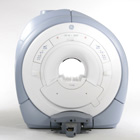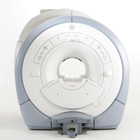 | Info
Sheets |
| | | | | | | | | | | | | | | | | | | | | | | | |
 | Out-
side |
| | | | |
|
| | | | |
Result : Searchterm 'Cryogen' found in 2 terms [ ] and 59 definitions [ ] and 59 definitions [ ] ]
| previous 46 - 50 (of 61) nextResult Pages :  [1] [1]  [2 3 4 5 6 7 8 9 10 11 12 13] [2 3 4 5 6 7 8 9 10 11 12 13] |  | |  | Searchterm 'Cryogen' was also found in the following services: | | | | |
|  |  |
| |
|

From Philips Medical Systems;
this active shielded member of the Panorama product line combines the advantages of one 1.0 T system's with the possibilities of an open MRI system. The open design helps ease anxiety for claustrophobic patients and increased patient comfort whereby the field strength provides spectacular image quality and fast patient throughput.
Device Information and Specification CLINICAL APPLICATION Whole body Vertically opposed solenoids, head, head-neck, extremity, neck, body/ spine M-XL, shoulder, bilateral breast, wrist, TMJ, flex XS-S-M-L-XL-XXL SE, FE, IR, STIR, FFE, DEFFE, DESE, TSE, DETSE, Single shot SE, DRIVE, Balanced FFE, MRCP, FLAIR, Turbo FLAIR, IR-TSE, T1-STIR TSE, T2-STIR TSE, Diffusion Imaging, 3D SE, 3D FFE, Contrast Perfusion Analysis, MTC;; Angiography: CE-ANGIO, MRA 2D, 3D TOFOpen x 47 cm x infinite (side-first patient entry) POWER REQUIREMENTS 400/480 V | |  | | | |
|  | |  |  |  |
| |
|
A quench is the rapid helium evaporation and the loss of superconductivity of the current-carrying coil that may occur unexpectedly, or from pressing the emergency button in a superconducting magnet. As the superconductive magnet becomes resistive, heat will be released that can result in boiling of liquid helium in the cryostat. This may present a hazard if not properly planned for.
The evaporated coolant requires emergency venting systems to protect patients and operators. Quenching can cause total magnet failure and cannot be stopped. MRI systems are designed such that all of the escaping cryogenic gas is directed out of the building ( quench pipe through the roof or the wall). In the event of a burst of the tank (possible in the case of an accident) or a blockage of the pipes, the helium gas will be forced into the scanner room, giving rise to a large white cloud of chilled gas. Under such circumstances it is essential that the scanner room is evacuated, also caused by the displacement of oxygen, which under extreme conditions could lead to asphyxiation. The force of quenching can be strong enough to destroy the walls of the scanner room or the MRI equipment. | |  | |
• View the DATABASE results for 'Quenching' (5).
| | | | |
|  | |  |  |  |
| |
|
A type of magnet that utilizes the principles of electromagnetism to generate the magnetic field. Typically large current values and significant cooling of the magnet coils is required. The resistive magnet does not require cryogens, but needs a constant power supply to maintain a homogenous magnetic field, and can be quite expensive to maintain.
Resistive magnets fall into two general categories - iron-core and air-core.
Iron-core electromagnets provide the advantages of a vertically oriented magnetic field, and a limited fringe field with little, if any, missile effects due to the closed iron-flux return path.
Air-core electromagnets exhibit horizontally oriented fields, which have large fringe fields (unless magnetically shielded) and are prone to missile effects. Resistive magnets are typically limited to maximum field strengths of approximately 0.6T. | |  | |
• View the DATABASE results for 'Resistive Magnet' (3).
| | | | |
|  |  | Searchterm 'Cryogen' was also found in the following services: | | | | |
|  |  |
| |
|

From GE Healthcare;
GE Healthcare has added the Signa HDe 1.5T™, a compact MRI device at an affordable price to its family of MRI products. It has a single electronic cabinet that can be positioned inside the scanner room rather than
in a separate equipment room. The Signa HDe 1.5T can be installed in the same physical location as 0.5T MRI systems with minimal construction costs. According to GE, the installation has been simplified to last only 7 days and has a 30 percent smaller footprint than a typical 1.5T system.
The 1.5T Signa™ HDe MRI system is substantially equivalent to the currently marketed GE 1.5T machines. The data acquisition system supports 1, 4, 8 independent receive channels and multiple independent coil elements per channel during a single acquisition series. The gradient specifications of HDe are lower than other GE Signa 1.5T MRI systems, but it can support clinical applications in cardiac and spectroscopy imaging.
Device Information and Specification CLINICAL APPLICATION Whole body CONFIGURATION Compact short bore 2D 0.7 mm to 20 mm; 3D 0.1 mm to 5 mm 128x512 steps 32 phase encode POWER REQUIREMENTS 480 or 380/415 less than 0.03 L/hr liquid helium | |  | |
• View the NEWS results for 'Signa HDe 1.5T™' (1).
| | | | |  Further Reading: Further Reading: | Basics:
|
|
| |
|  | |  |  |  |
| |
|

From GE Healthcare;
The GE Signa HDx MRI system is a whole body magnetic resonance scanner designed to support high resolution, high signal to noise ratio, and short scan times.
The 1.5T Signa HDx MR Systems is a modification of the currently marketed GE 1.5T machines, with the main difference being the change to the receive chain architecture that includes a thirty two independent receive channels, and allows for future expansion in 16 channel increments. The overall system has been improved with a simplified user interface
and a single 23" liquid crystal display, improved multi channel surface coil connectivity, and an improved image reconstruction architecture known as the Volume Recon Engine (VRE).
Device Information and Specification CLINICAL APPLICATION Whole body CONFIGURATION Compact short bore Standard: SE, IR, 2D/3D GRE and SPGR, Angiography: 2D/3D TOF, 2D/3D Phase Contrast; 2D/3D FSE, 2D/3D FGRE and FSPGR, SSFP, FLAIR, EPI, optional: 2D/3D Fiesta, FGRET, Spiral, Tensor, 2D 0.7 mm to 20 mm; 3D 0.1 mm to 5 mm 128x512 steps 32 phase encode POWER REQUIREMENTS 480 or 380/415 less than 0.03 L/hr liquid helium | |  | | | |
|  | |  |  |
|  | |
|  | | |
|
| |
 | Look
Ups |
| |